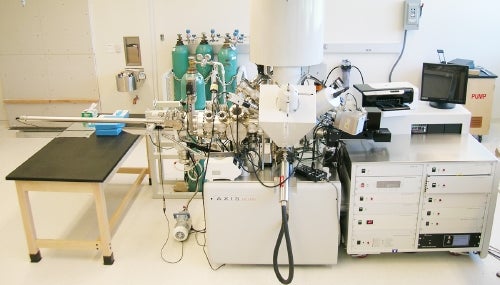Kratos XPS Analytical Facility
A Kratos Analytical AXIS Ultra Delay-Line Detector (DLD) Imaging XPS is available for sample analysis. This instrument has both monochromatized and non-monochromatized X-ray sources and spatial imaging capabilities. It is also equipped with a vacuum ultraviolet light source for ultraviolet photoelectron spectroscopy (UPS), a resterable ion gun for sample cleaning, depth profiling, and low-energy ion scattering (LEIS), an electron gun for scanning Auger electron spectroscopy (AES), a sample holder with cooling, heating, and five degrees (X, Y, Z, tilt, azimuthal) of motion, a load-lock sample introduction and transferring system, a sample preparation chamber, and appropriate software.
General Information Services Offered Price Structure Instrumental Features Acknowledgements
General Information
This XPS instrument is available for analysis of samples from all members of the UCR community as well as from outside users.
The instrument is located in Room 0162 of the new UCR Materials Science and Engineering Building.
The facility is being operated by Dr. Ilkeun Lee, and administered by the UCR Analytical Chemistry Instrumentation Facility (ACIF).
Currently, all samples are to be analyzed by Dr. Lee. No student training or access to the instrument is available at the present time.
Technical supervision is being provided by Prof. Francisco Zaera.
Services Offered
The capabilities of this instrument include:
- Routine XPS analysis of samples. This includes wide scans and detailed analysis of specific elements. Binding energy resolution down to approximately 0.4 eV may be obtained by using the monochromatized X-ray source.
- Depth profile and angle-resolved XPS studies to investigate the composition variations of the sample versus depth.
- Spatially resolved XPS images, down to a few microns resolution. Individual spectra can be acquired on specific points of the sample.
- UPS spectra using both He I (21.2 eV) and He II (40.8 eV) UV sources. Other wavelengths (using other rare gases) may be possible.
- Regular LEIS analysis for compositional analysis of the topmost layer of the surface.
- Scanning electron microscopy (SEM) imaging, down a few microns, and spatially resolved AES analysis using electron excitation.
Price Structure
The current price structure is as follows:
- Internal Customers: $52/unit.
- External Academics: $113/unit.
- Commercial Customers: $153/unit.
Please contact Dr. Lee to know how many units are required for your samples. It depends on the numbers of samples and elements to be scanned if the sample size is suitable.
Instrumental Features
The Kratos AXIS Ultra DLD instrument is based on a main ultrahigh vacuum (UHV) chamber with a base pressure of approximately 5E-9 Torr during operation, and has a number of special features, including:
- A 165-mm mean radius electron energy analyzer for spectroscopy.
-
- The largest hemispherical analyzer available in the market. It provides maximum transmission (and therefore sensitivity) and energy resolution.
-
- A Spherical Mirror Analyzer for imaging.
-
- Required for the real-time, fast, high spatial resolution imaging.
- Has high-energy resolution, enabling real-time elemental and chemical state images to be acquired.
- Allows a constant energy resolution to be used in the image mode, ensuring accurate chemical state work to be accomplished.
-
- Combined electrostatic/magnetic electron transfer lens.
-
- Provides high sensitivity by allowing a large collection solid angle. Essential for small spot analyses, where sensitivity is the most important.
- Angular collections up to +/- 25 degrees.
-
- Co-axial, low energy (~0.1 eV) electron flood source for charge neutralization.
-
- A combined magnetic/electrostatic lens allows for the incorporation of a co-axial (i.e. normal to the sample surface) charge neutralization system to be used. Required for high-energy resolution on insulating materials when using the X-ray monochromator.
- Universal settings allow spectroscopic analysis to be carried out on a wide range of insulating samples without operator intervention.
- Electron-only neutralizer minimizes potential surface damage on sensitive materials.
-
- Delay Line Detector for spectroscopy and imaging.
-
- Pulse counting detection system, used for both spectroscopy and imaging. Allows for direct quantitative images to be acquired in the same way that quantitative spectra are acquired.
- The use of the same detector for spectroscopy and imaging allows for direct comparison between spectral and image data.
- Allows direct parallel, high-resolution spectra to be acquired rapidly. Particularly beneficial in depth profiling applications, where acquisition times can be significantly shortened compared to traditional scanning methods.
- Up to 120 detector elements available for use in the spectroscopy mode. This enhances sensitivity, particularly for small spot analyses, and peak shapes for high-resolution chemical state identification.
-
- 500-mm Rowland circle X-ray monochromator.
-
- Narrow energy dispersion within the illuminated X-ray spot.
- Non-focused system enables higher energy resolution from smaller analysis areas due to the reduced energy dispersion within the X-ray spot.
-
- The sample stage on the Axis Ultra provides extensive sample handling capability, with true +/- 90 degrees tilt capability for angle resolved XPS measurements.
Acknowledgements
This instrument was acquired with funds from the U.S. National Science Foundation under their Major Research Instrumentation Program.
Please acknowledge NSF grant DMR-0958796 in all published science that includes data acquired with this instrument. Also please inform Prof. Zaera and send him a copy of the paper for reporting purposes.
The operational cost of this facility is being partially subsidized by the UCR Office of Research and Economic Development.
